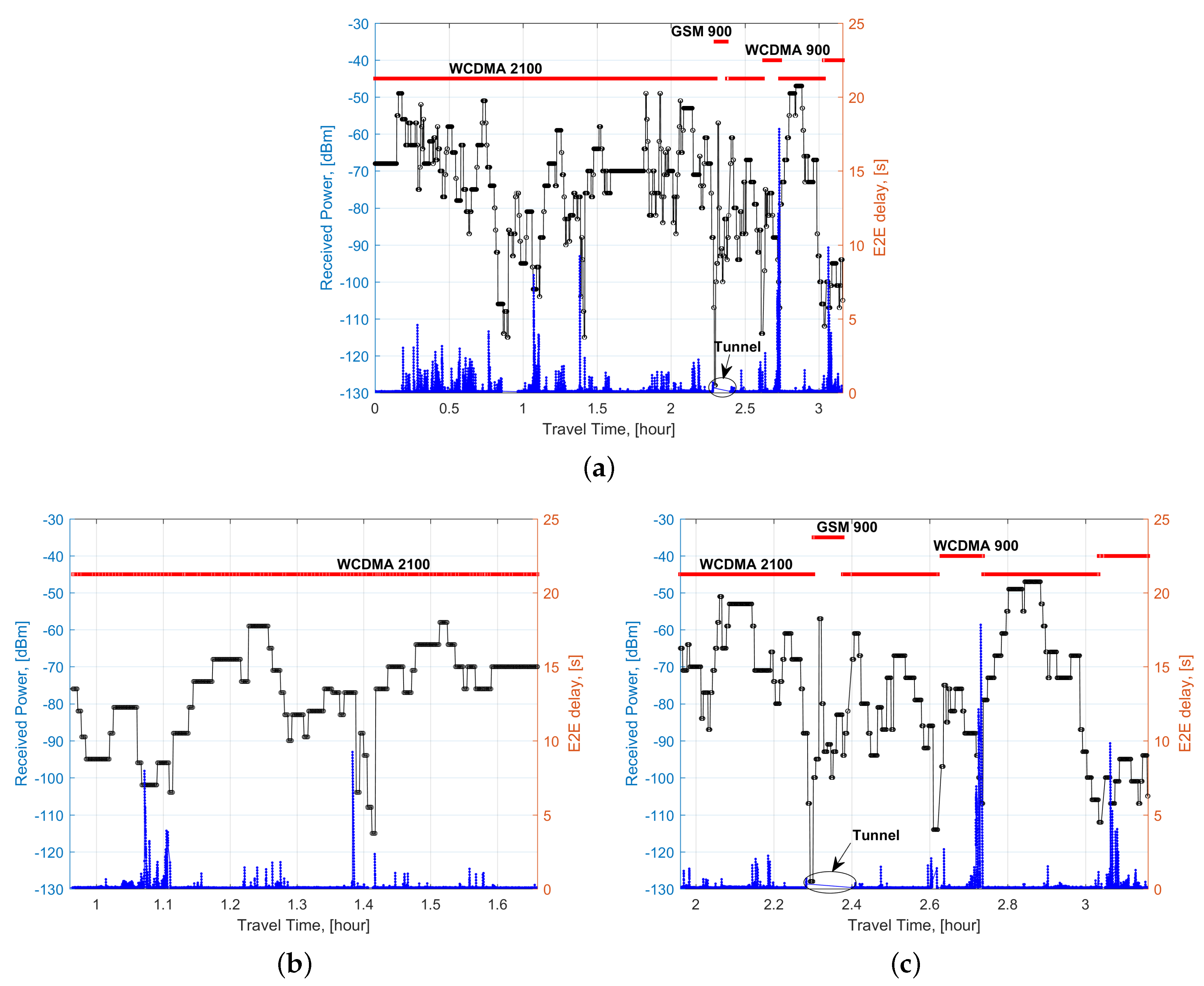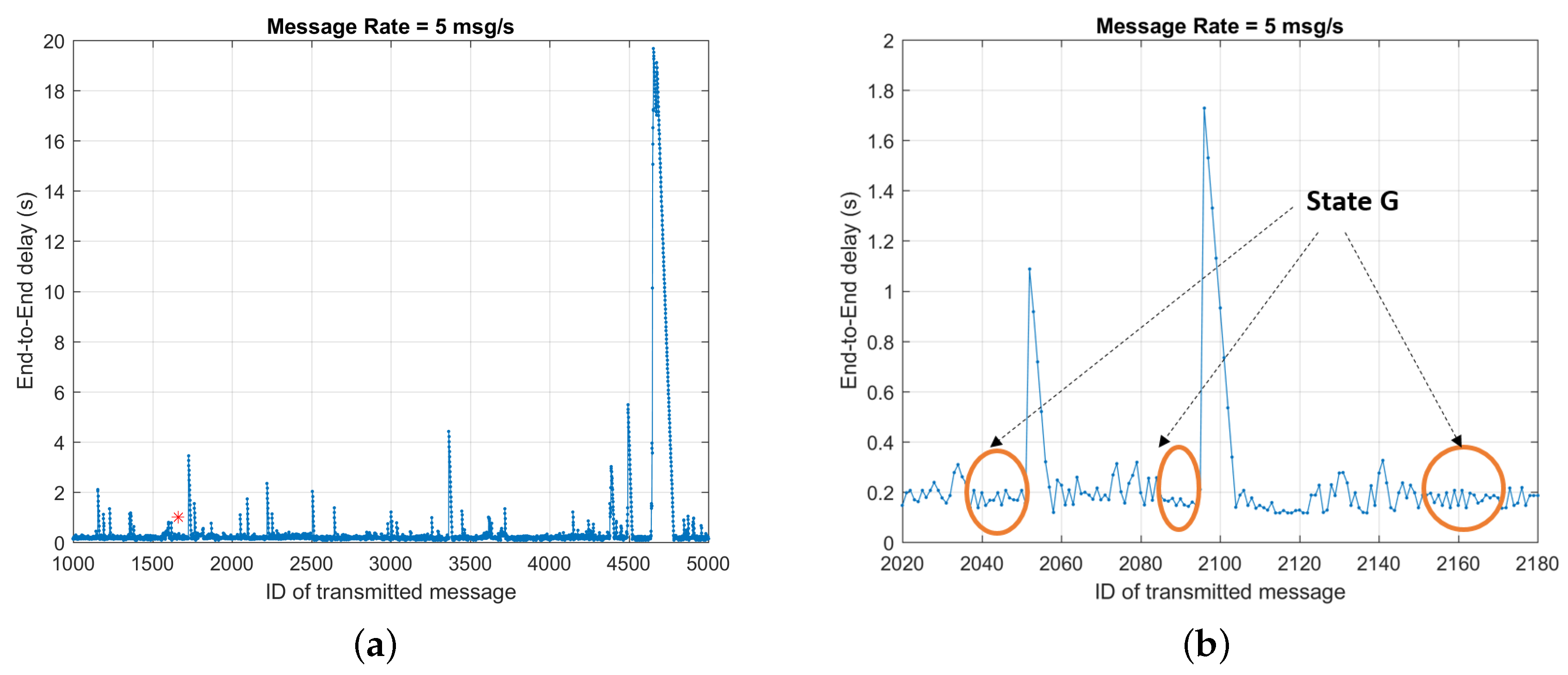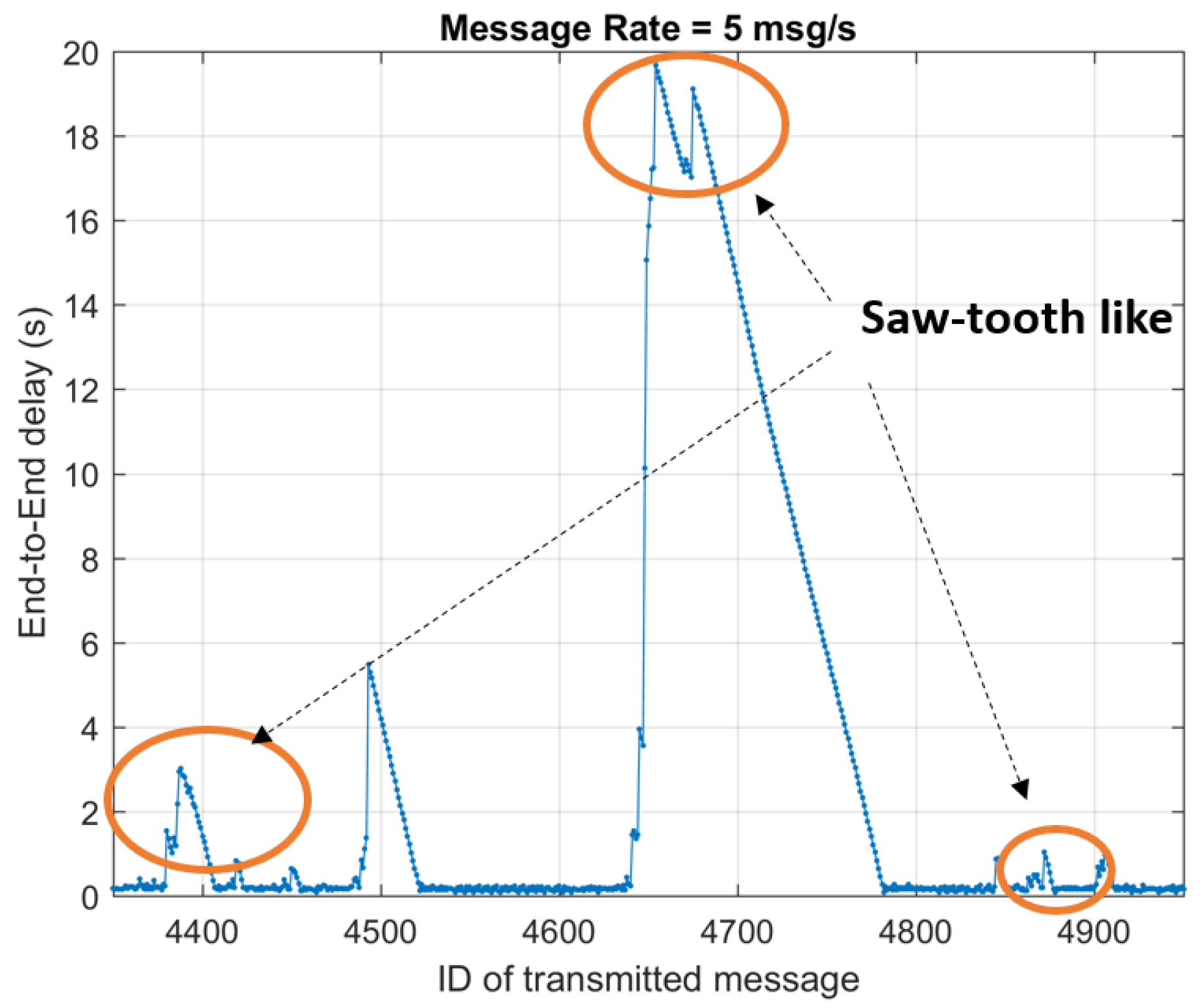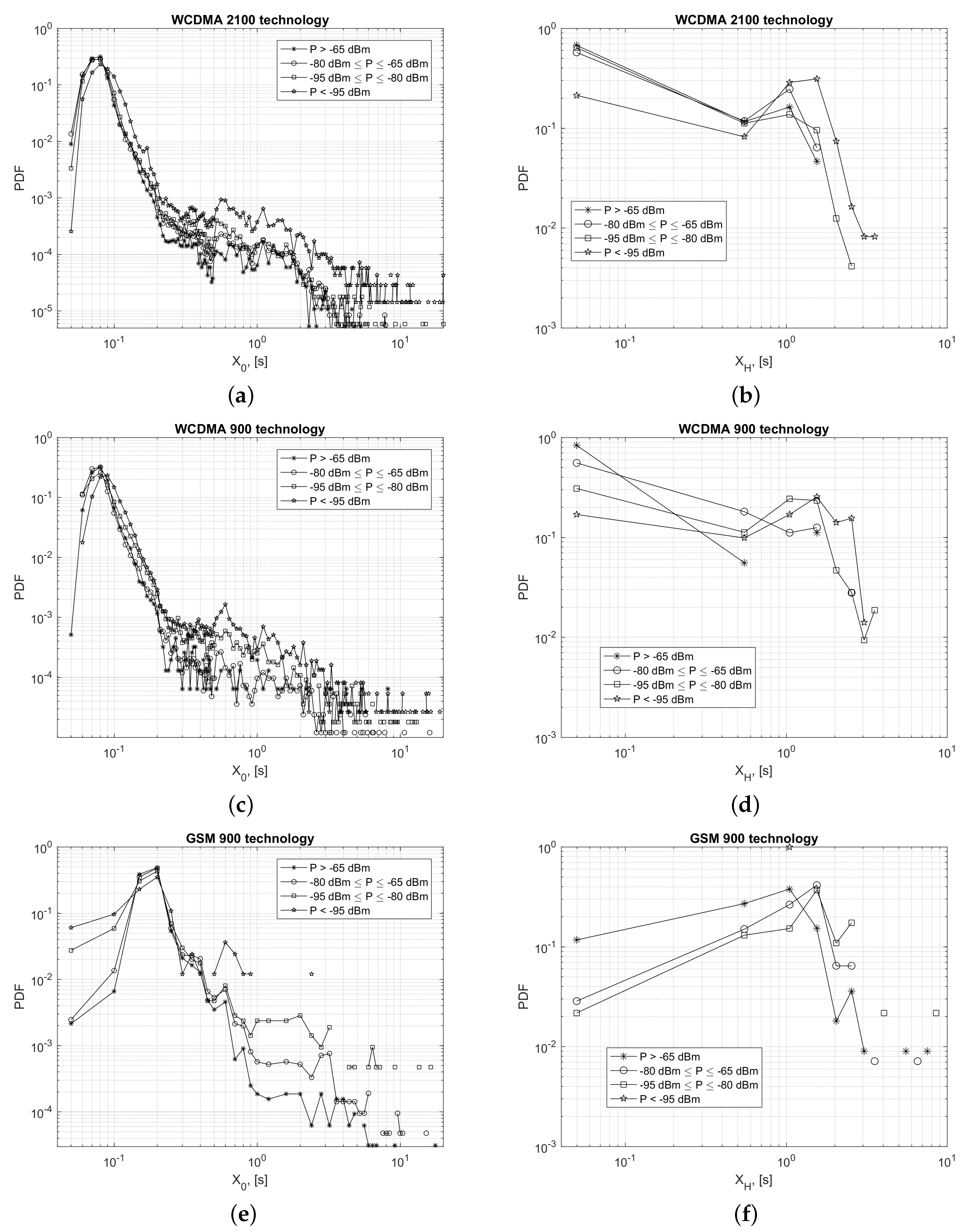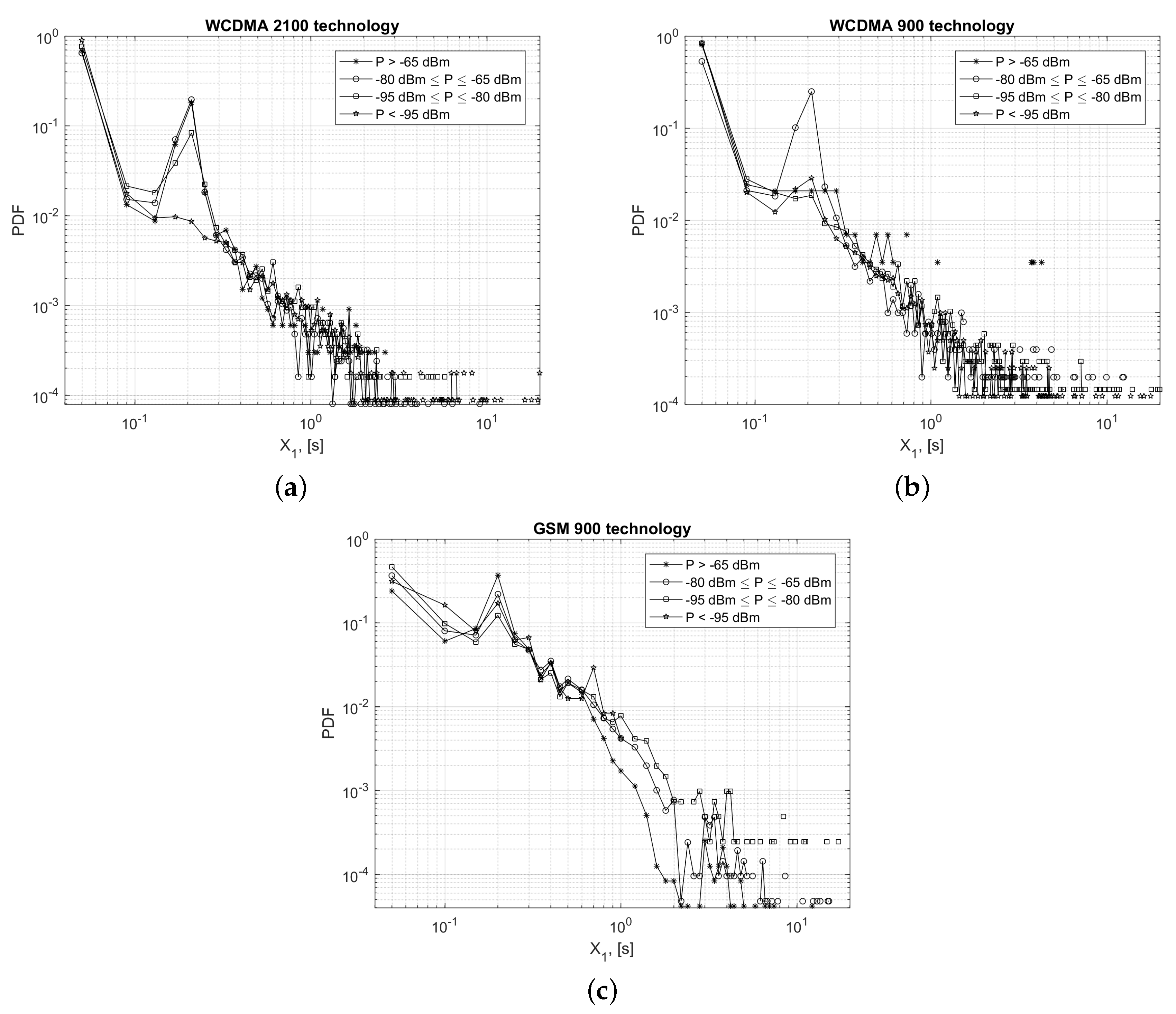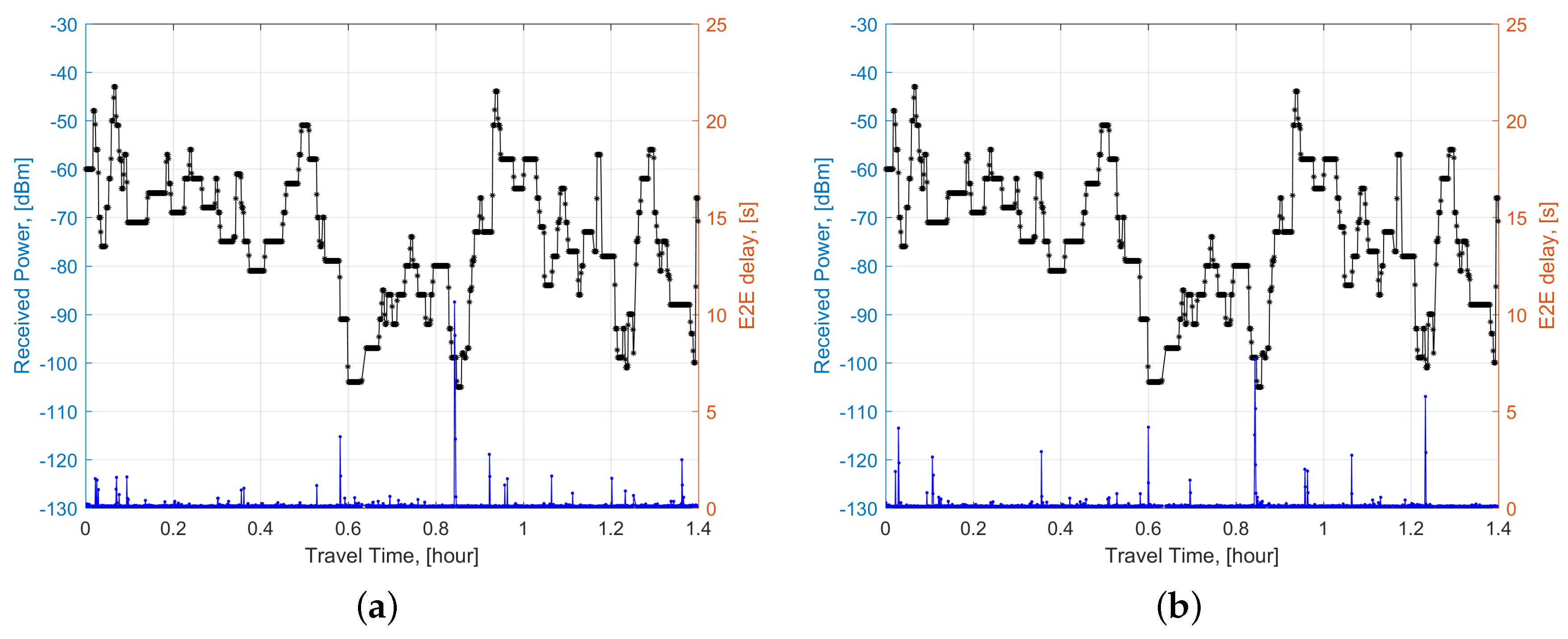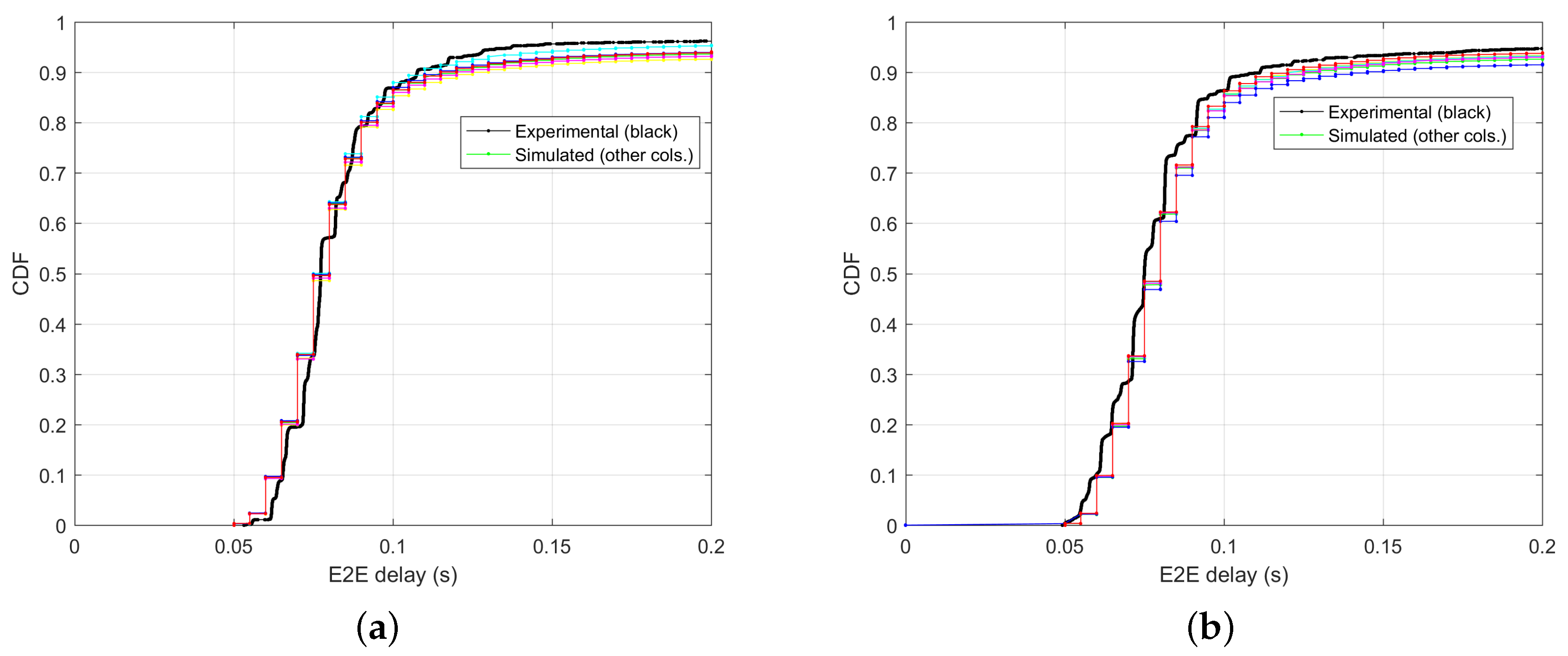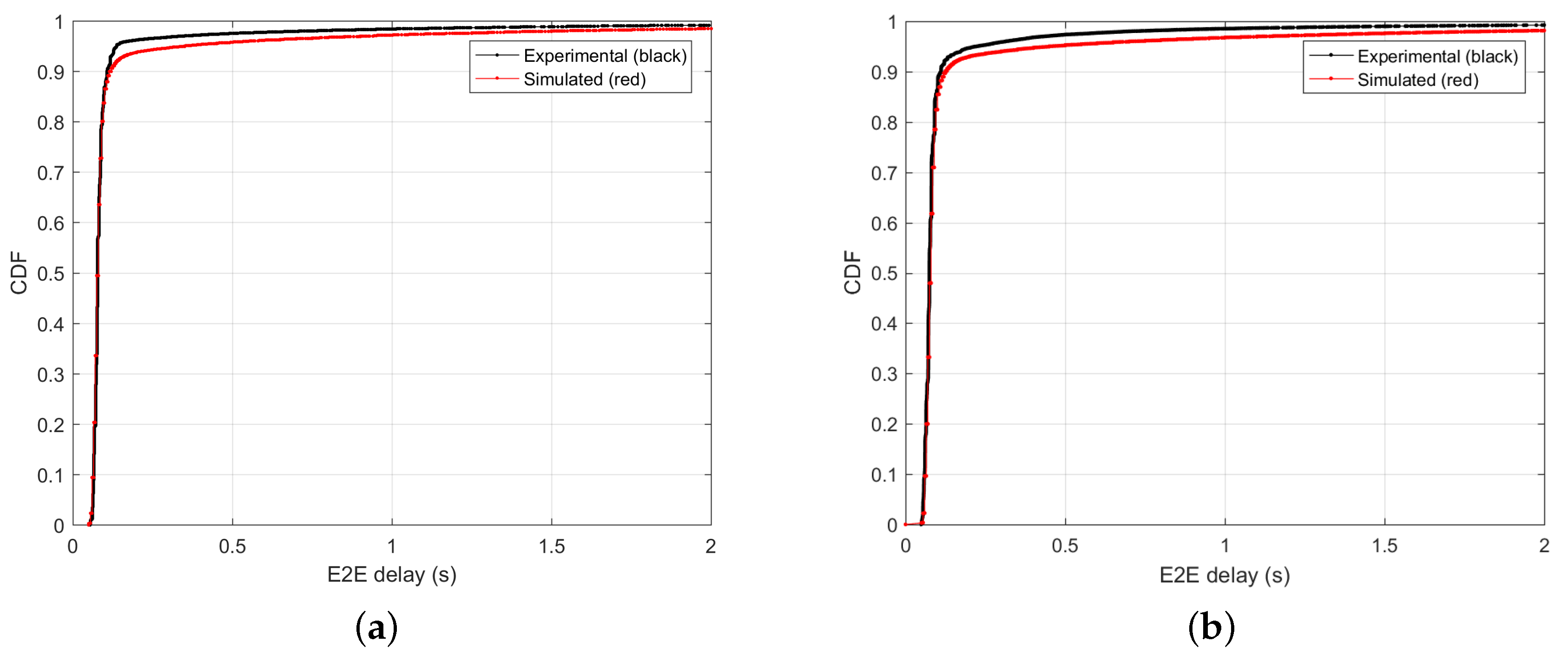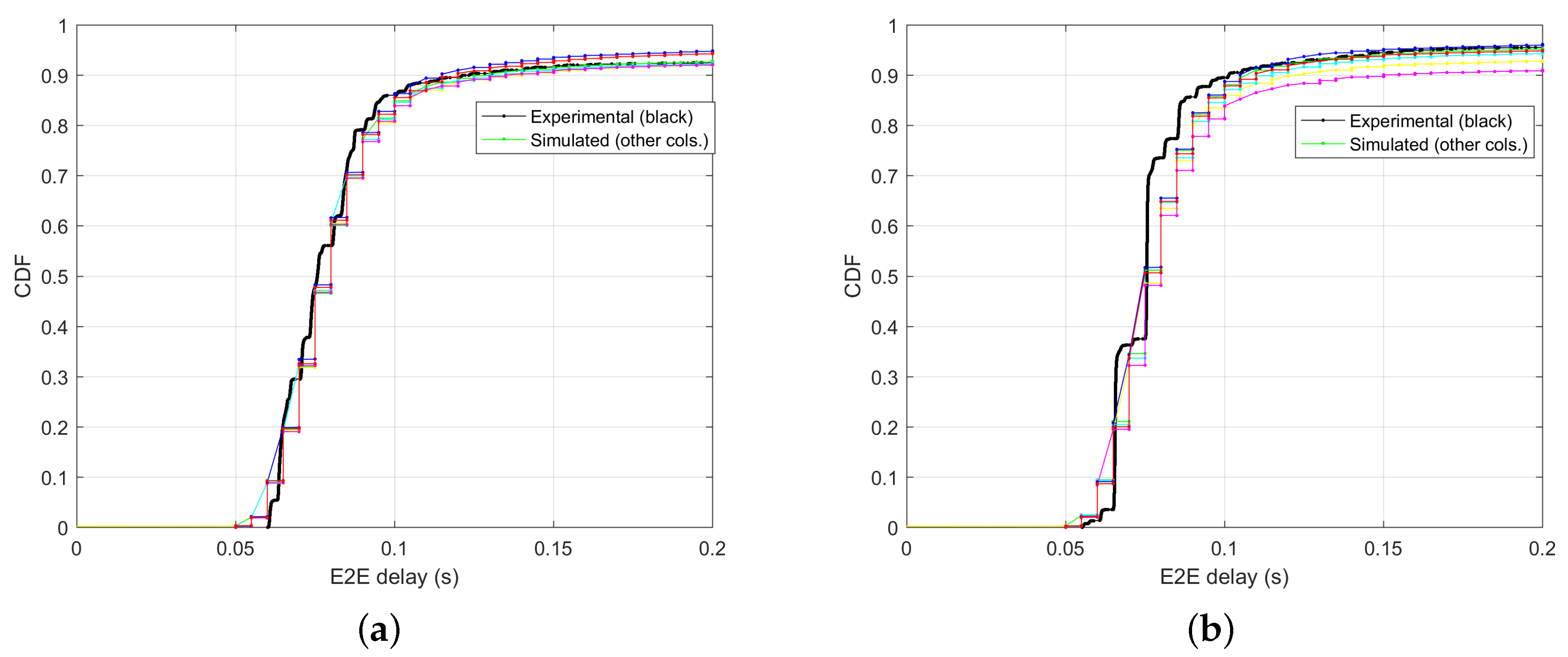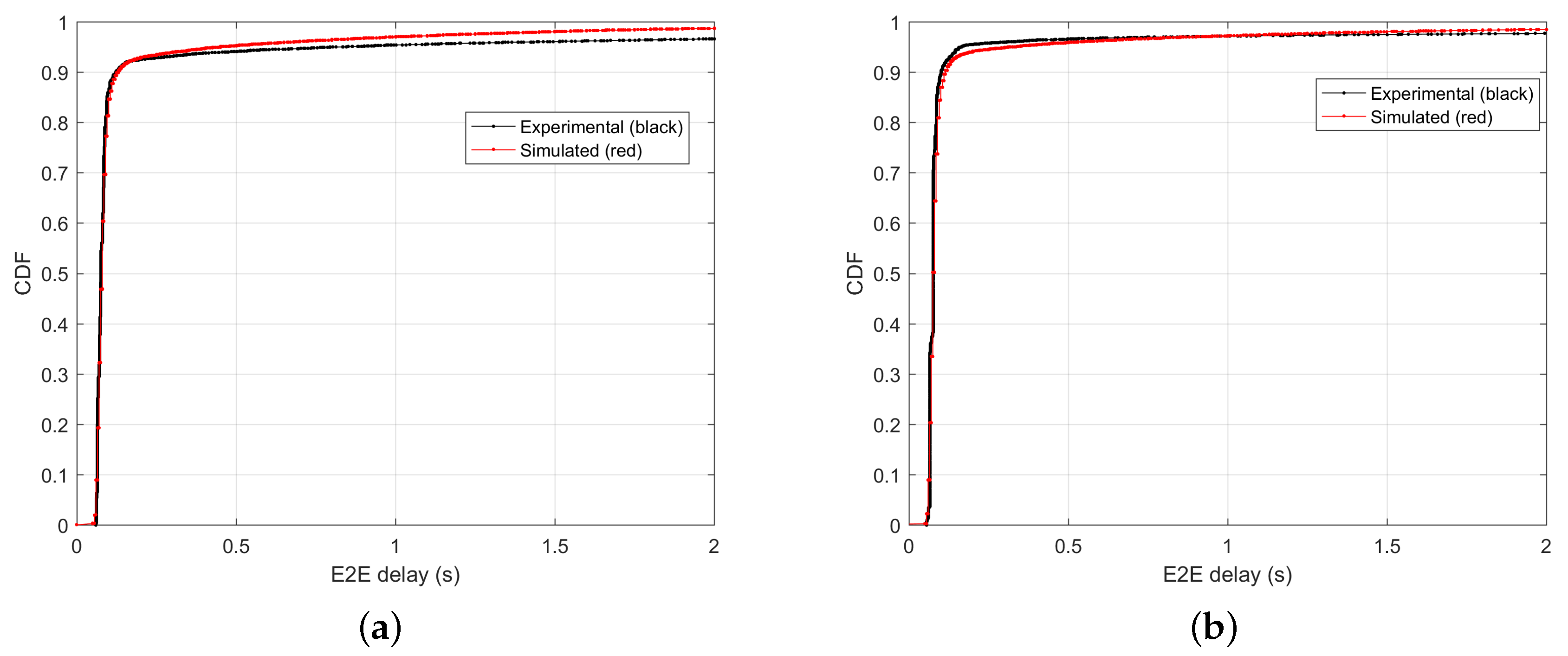1. Introduction
Future railway communication systems will integrate a variety of systems, each of them specialized to specific services [
1]. The communication platform for railway management will be oriented towards a unified infrastructure to increase efficiency, speed up the business processes, increase operational effectiveness, facilitate information exchange and improve the quality of decision-making. Other and new applications for railways are discussed in [
2]. However, to provide broadband communication services for railways (even beyond those services supporting control and management functionalities), innovative communication systems’ architectures should be considered sometimes disregarding the existing infrastructure(s) along the line [
3,
4]. Moreover, recent advances on the Internet of Things (IoT) open a way to several innovative use cases and applications for creating a connected railway mainly oriented to passengers including: journey planner, social networking apps, gathering status information from diverse on-board public-facing assets, such as toilets, food car chiller, etc., real-time alarms for potential problems, allowing for more timely intervention responses and potentially reducing service outages and many others [
5].
Effective management of railway operation processes will require highly reliable and stable telecommunication platforms, supporting new operational modes enabling the increasing of the railway traffic capacity while ensuring high security and safety levels.
The European Rail Agency (ERA) has undertaken studies to evaluate possible options for the evolution of the Global System for Mobile Communications-Railways (GSM-R) that will have to be replaced in the next few years. However, in the definition of a viable solution, two major challenges arise: to comply with the interoperability requirement, as done by the GSM-R today, and, from the train operator side, to protect the investments on the GSM-R. In addition, a migration to full IP-based telecom systems could facilitate the evolution towards a full service-based system for all rail applications [
6].
Thus, the main body of current research on railway communication is mainly focused on the application of IP-based radio networks, such as LTE (Long Term Evolution), to high speed railway lines. The problem of supporting train control services by the LTE system is considered in [
7]. Authors propose solutions based on modifying QoS (Quality of Service) policies, adjusting some cell parameters with respect to cell planning performed by the operator or optimizing procedures to resolve any network issue. These solutions can be costly for the railway owner. Concerning cost reduction, a first breakthrough in economic sustainability is represented by the replacement of proprietary/dedicated networks based on GSM-R, with public networks such as the cellular and satellite networks operated by commercial operators (mobile network operator, MNO). The use of public telecommunication infrastructure(s) makes it possible to rapidly extend the existing automated train control procedures (such as the European Rail Traffic Management System/European Train Control System (ERTMS/ETCS), and communications based train control [
8]) for improving rail traffic capacity for local/regional lines where the deployment of a dedicated radio infrastructure is expensive in terms of both CAPEX (Capital Expenditures) and OPEX (Operating Expenditure). Furthermore, public networks can be considered as low cost and effective enablers for the rapid deployment of the modern railway information systems such as those proposed and investigated in the InteGRail project [
9]. This innovative scenario would imply a step-change in the liability process with the introduction of guaranteed QoS in the provisioning of mobile connectivity services by telecommunication operators.
In the last few years, other important European research projects investigated on the railway communications. The RobustRail project [
10] has studied the possibility of replacing the GSM-R with LTE in the railway scenario. The Railenium project [
11] is concerned with the intelligent interaction between the infrastructure and vehicles to optimize both the performance of signalling systems and railway transport capacity. The Satloc project has addressed the adoption of the European Geostationary Navigation Overlay Service (EGNOS) for train positioning and speed determination [
12]. Several papers have investigated the introduction of LTE for railway communications. In [
13], authors investigate the use of LTE micro-cell deployment in high-density railway areas to support bandwidth hungry applications. Other papers have focused on transmission performance for high-speed trains, tackling problems due to Doppler shift [
14], problems caused by too frequent base-station handovers [
15] and retransmissions protection to provide data integrity as in [
16].
To evaluate the performance of train control procedures based on public radio networks, channel characterization is important, as also highlighted in [
17]. Authors in [
17] report the main results of a measurement campaign in China for high-speed railway communications. As shown in [
17], due to high channel dispersion and variability, authors propose the adoption of solutions to be considered in the design phase of the LTE system, such as Coordinated Multi Point and the cell combination for improving performance.
In the 3InSat project [
18] within the framework of the European Space Agency (ESA) Advanced Research in Telecommunications Systems (ARTES) 20 programme, by means of an experimental campaign, we have investigated on the possibility of achieving acceptable QoS on public terrestrial networks integrated with satellite [
8,
19] as the economical feasibility of this approach. Considering that in the short/medium-term radio bearers provided by public networks will offer best-effort services, in [
18], we also made evidenced that the satellite is an important component to achieve the required QoS levels. Performance results in [
8] suggest that the usage of a public radio network including satellite for supporting train control communications is a viable choice for actual and future railway communications on local/regional lines. Typical propagation models used to assess communication performance on the railway focus on transmission aspects at the physical (PHY) layer [
17,
20]. In this paper, we model the behavior of the radio transmission channel as seen by the railway control applications, which run on the on-board European Vital Computer (EVC) and at the Radio Block Centre (RBC). In this case, the channel behavior can be completely characterized by the end-to-end (E2E) delay and by the loss probability of the control messages exchanged by the applications. The E2E delay channel model presented in this paper allows the railway operator to evaluate performances of train control procedures, whose messages exchanged between the railway control applications (i.e., EVC and RBC) are sent on a public radio network managed by a telecommunication operator. In this case, for the railway operator, it is not possible to know exactly the behavior of the public radio network as well as to influence it in any way. The railway operator can only infer/measure the E2E delay for the messages sent by applications.
The proposed E2E delay model aims at reproducing the main behavioral characteristics of the process describing the E2E delay as observed from experimental data [
18] obtained over a regional line. It is shown that the proposed model can be applied to generate the E2E delay for a generic railway line when the positions of handover areas have been identified along the line and the received power levels and information on the radio serving technologies are available. The model can be used for preliminary performance analysis of railway control procedures for trains moving over local/regional lines. Furthermore, our model can also be used to study and infer the performance of IoT applications exchanging messages with the ground segment. Finally, the validity of the proposed model has been assessed by comparing the cumulative distribution function of the E2E delays generated by the model with those obtained from measurements. The E2E delay model presented in this paper is obtained from experimental results concerning the terrestrial radio networks only.
The paper is organized as follows. In
Section 2, we summarize the main characteristics of the experimental setup used to measure E2E delay profile on the selected local/regional railway line. In
Section 3, we outline the main features concerning the behavior of E2E delay and the message loss over the railway as emerging from the analysis of the available experimental data. These features are then used to derive the E2E delay model, which is presented in
Section 4. The practical usage of the two states E2E delay model is discussed in
Section 5. The experimental statistics of the random variables driving the proposed two states model are introduced in
Section 6. To prove the ability of the proposed model in reproducing the behavior of the E2E delay, we apply it to an example of a realistic railway scenario. In the same section, we provide results concerning the validation of the proposed model. Finally, conclusions are drawn.
3. Analysis of Experimental Data
The analysis of experimental data is the first step required to provide evidence of the main features characterizing the behavior of the E2E delay over the rail line. The resulting E2E delay model should reproduce the features emerging from this analysis. In
Figure 3, we plot one sample of the E2E delay as a function of the travel time as obtained during the experimental campaign. On to the same picture, we have superimposed the corresponding received power profile associated with the transmitted messages (one message every 200 ms in this case). In the same picture, we have also indicated the serving radio technology connecting the terminal along the railway path. At the moment of the measurement campaign, LTE was not present in the considered sub-urban/rural areas. Anyway, it is expected that LTE is and will be mainly deployed in high-densely populated areas. Thus, for regional lines, it is more appropriate to consider 2G and 3G radio technologies.
The presence of the tunnel has been made evident in the picture. At the time of measurements, the
km long gallery was not equipped with any radio technology and roaming with GSM 900 technology was not performed until the train exits the gallery. In the following part of this section, we proceed with the examination of the measured E2E delays in order to assess the main features to be owned by the model to reproduce behavior similar to that in
Figure 3.
In the G state, the E2E delay is (practically) bounded within hundreds of milliseconds (see circled areas in
Figure 4b), sometimes taking values higher than the messages generation interval (e.g., 200 ms), thus causing enqueuing of messages and then a transition in the state Q (see below).
In
Table 1, we report a sample of the E2E delays obtained from measurements representing the behavior in state G. The E2E delays and the corresponding transmission and receiving timestamps have been also indicated.
Figure 3b,c are two zooms of
Figure 3a. From results in
Figure 3b,c, we can observe a correlation between the received power level and the experienced E2E delays. This relation will be studied in the section concerning the parameters of the E2E delay model presented in this paper. The typical pattern of the E2E delay profile obtained from experimental data is shown in
Figure 4a. The plot in
Figure 4b is a zoom of
Figure 4a.
Figure 4a provides evidence of a two states-like behavior for the E2E delay. Thus, we can introduce two distinct macro-states that, for convenience, we label as Good (G) and enQueued (Q).
From data in
Table 1, in some cases (see numbers in bold), the receive time of the message can be greater than the transmit time of the successive message.
This event can be explained assuming messages have been buffered in the transmitter when the link becomes (temporarily) unavailable and, more in general, due to buffering in any part of the traversed network sections (e.g., Radio Access Network (RAN), backbone, core). In the case of buffering in the transmitter, for messages of constant length, the speed for emptying the buffer depends on the assigned channel bit rate over the wireless link when it returns as available. In general, the instantaneous link bit rate can be considered as random, and its value depends on the locally available radio technology(ies) (e.g., 2G, 3G or 4G), on the traffic load in the cell and on the scheduling strategy of the serving base station (BS).
In the Q state, a large number of messages could be buffered due to link unavailability even for a relatively long time.
In this case, large transmission delays have been experienced leading to the high spikes in the E2E delay as evidenced in
Figure 4.
To better understand the nature of these events, we have correlated the time the messages are sent with the positions of the train along the line. We have observed that these phenomena can be related to the received power level, the actual serving radio technology and to the (hard) handover/roaming events. In some sporadic cases, very large E2E delays (on the order of about one minute or more) have led to the automatic reset of the measurement equipment. This has caused the loss of several consecutive messages and, obviously, their IDs have not been recorded at the receiver side. These events have been discarded from the data set used to derive the model presented in this paper. Finally, when the channel is in state Q and the generation rate of the messages is relatively high (e.g., 5 msg/s), buffering of messages to be transmitted may occur frequently. This leads to the saw-tooth like behavior made evident in
Figure 5.
The cases in
Figure 4 and
Figure 5 are for illustrative purposes only of the main phenomena we need to consider for E2E delay modeling.
Before concluding this section, we have also observed the presence of sporadic losses of one or more messages indicated in the previous figures with asterisks. From further analysis, we have observed that sporadic losses are un-correlated and can occur randomly regardless of the channel state G or Q. The message loss probability has been evaluated from experimental results and for different message rates. If we exclude events causing the reset of measurement devices and losses due to coverage holes along the line, we have observed the presence of sporadic messages loss due to momentary bad radio link and/or to message forwarding in the core network. Even though the Vodafone network could be based on a Virtual Private Network Point-to-Point (VPN P2P) link, it still may experience random un-bounded delays. This could be one of the possible causes leading to reset of measurement equipment. From extensive data analysis, after excluding (un-wanted and un-predictable) equipment reset events, we have obtained a (sporadic) message loss probability of about
. This value is not surprising. In fact, the service provided by Vodafone was optimized for M2M communications; presumably, it implements high availability and buffering solutions for reducing/avoiding message loss. In general, it is envisaged that the railway operator will request the MNO for reliable and secure message transmission services for the transport of signaling information. If we even include all the events leading to loss of message sequence (such as the presence of coverage holes and tunnels without radio facilities inside, etc.), the loss probability may raise up to
as indicated in [
19]. However, the positions of tunnels and coverage holes are known in advance so that connection failure can be predicted and properly taken into account for train management operations.


